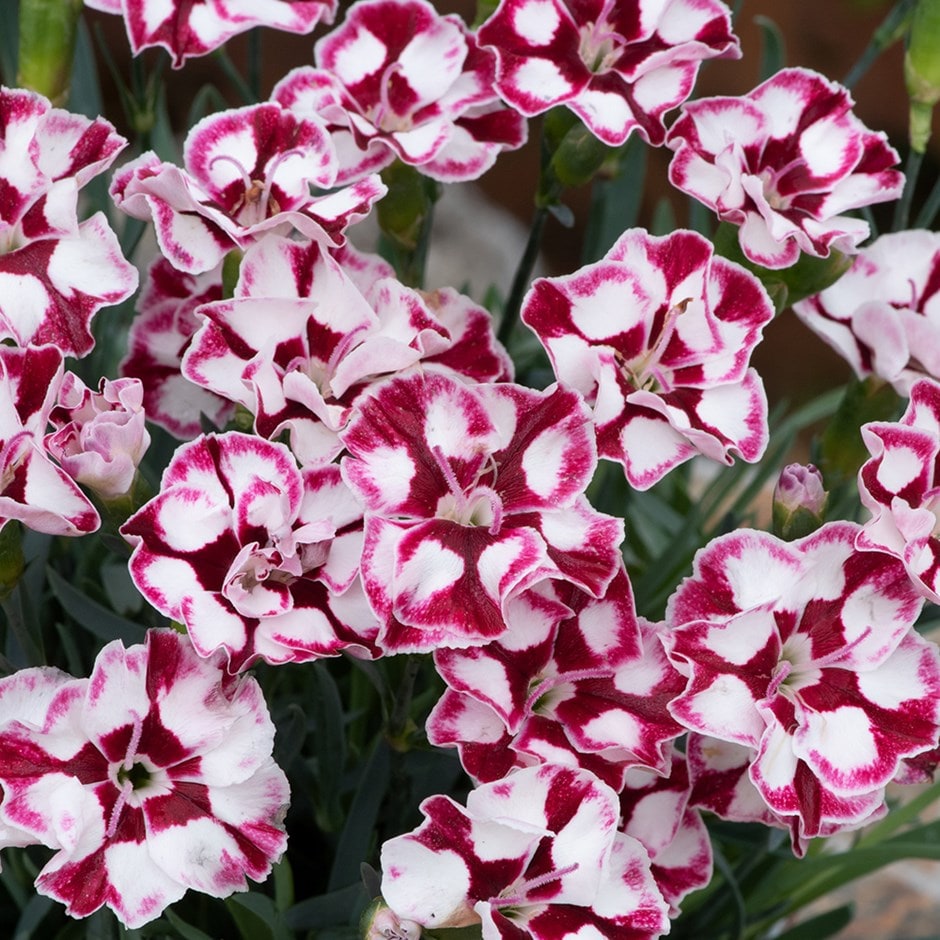
A scented ‘pink’ that loves to show off! The flowers are mostly semi-double in nature, prolific (if deadheaded), and convoluted with vibrant raspberry ripple markings. Dianthus ’Cremarena’ carries a light fragrance, and the mild winter persistent grey-green foliage is noteworthy as it contrasts well with so many other green plants.
A beautiful plant for the front of borders, rock gardens and patio pots, the name Dianthus comes from the Greek words dios meaning divine and anthos meaning flower.
A beautiful plant for the front of borders, rock gardens and patio pots, the name Dianthus comes from the Greek words dios meaning divine and anthos meaning flower.
How to care for Dianthus (Allwoodii Group) Diantica Cremarena:
Prefers soil enriched with well-rotted manure or garden compost and an application of a balanced fertiliser in spring. Dianthus should be trimmed back lightly after flowering to promote new growth at the base of the plant. Prune more closely in spring, as new shoots emerge to maintain a tidy shape.
Flowering period:
- Jan
- Feb
- Mar
- Apr
- May
- Jun
- Jul
- Aug
- Sep
- Oct
- Nov
- Dec
Eventual height:
0.5m
Eventual spread:
0.5m
Position:
Full sun
Rate of growth:
Average
Soil:
Moderately fertile, moist but well-drained soil, or peat-free general purpose compost
Hardiness:
Fully hardy
-
This perennial is semi-evergreen so it can lose some of its leaves in winter. In colder regions or more exposed gardens, it may lose them all, but then fresh new growth appears again in spring.
-
Humans/Pets: Skin allergen
Product options
Delivery options (pick your preferred option at checkout)

A scented ‘pink’ that loves to show off! The flowers are mostly semi-double in nature, prolific (if deadheaded), and convoluted with vibrant raspberry ripple markings. Dianthus ’Cremarena’ carries a light fragrance, and the mild winter persistent grey-green foliage is noteworthy as it contrasts well with so many other green plants.
A beautiful plant for the front of borders, rock gardens and patio pots, the name Dianthus comes from the Greek words dios meaning divine and anthos meaning flower.
A beautiful plant for the front of borders, rock gardens and patio pots, the name Dianthus comes from the Greek words dios meaning divine and anthos meaning flower.
How to care for Dianthus (Allwoodii Group) Diantica Cremarena:
Prefers soil enriched with well-rotted manure or garden compost and an application of a balanced fertiliser in spring. Dianthus should be trimmed back lightly after flowering to promote new growth at the base of the plant. Prune more closely in spring, as new shoots emerge to maintain a tidy shape.
Flowering period:
- Jan
- Feb
- Mar
- Apr
- May
- Jun
- Jul
- Aug
- Sep
- Oct
- Nov
- Dec
Eventual height:
0.5m
Eventual spread:
0.5m
Position:
Full sun
Rate of growth:
Average
Soil:
Moderately fertile, moist but well-drained soil, or peat-free general purpose compost
Hardiness:
Fully hardy
-
This perennial is semi-evergreen so it can lose some of its leaves in winter. In colder regions or more exposed gardens, it may lose them all, but then fresh new growth appears again in spring.
-
Humans/Pets: Skin allergen
